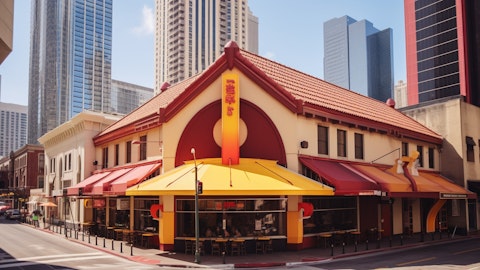I think what is important [indiscernible] is we have to remain quite open minded and continue to relearn and reconnect with our consumer. And that’s exactly what we have been doing, and we’ll continue to do that. And we — in the last few years, you can see that we learn from local players who launched Chinese burger, we learn it. We learn from other players about the possibility of the whole chicken. We learn from other competitors in pizza category, the focus on the lower priced pizza. And that’s how we compete in this market, and we’ll continue to stay agile. And the market will always be choppy, but that’s okay. We are here to stay, and it will continue to test our ability to compete. And our strategy is always very consistent for KFC. The ticket [ph] is about in the long-term, we make sure that our ticket average is relatively stable by having high- ticket average item, such as beef burger or whole chicken, and then have the entry price product to grow the transaction and et cetera.
And then for Pizza Hut, again is very consistent, is to drive down the TA actually. 2017, our TA was 132. Now it’s 90. We’ll continue to drive it down because that TATC strategy has to be consistent with our mass market store growth strategy. So we will have the sort of the stable and consistent strategy to compete in this market. Thank you.
Chen Luo: Thank you.
Operator: Thank you. The next question comes from Lillian Lou from Morgan Stanley. Please go ahead.
Lillian Lou: Thanks, Joey and Andy. I have a question about — Joey, you commented on the diversified consumer demand. Right now, and there has been some widening so-called the holiday effect. And are we seeing actually from store performance as well, given that situation, there is more gap between best performing stores or relatively worse performing stores, at stores in different locations. For example, the heavy traffic hubs, of course, so more of an underlying bigger debt in terms of the store performance. And I mean, reacting to that, we continue to deliver better efficiency and cost savings. So trying to understand better from this challenge of multisite top performance or customer demand, how we manage, keep saving more. I think Andy and Joey mentioned a little bit about trying to dip in a little bit better understanding for the ongoing cost saving programs. Thank you.
Joey Wat: Thank you, Lillian. Well, first of all, I would like to report that for the small diverse demand between the — sort of the splurge consumption during the holiday and a bit more tightening the belt after the holiday. That is not that unique. I spent 10 years in U.K. Consumer, they are excited the same despite the cultural difference or language difference. So we just learn to train our business better and better. So how do we deal with it? How do we meet the diverse demand? During the holiday, we focused on the high ticket trading, like the bucket of the whole chicken, beef burger, so that our customer can splurge. But at the same time, we will also thrive the TC, like Chinese New Year is a great example. The location [indiscernible] actually is lower tier city and the transportation hub and tourist location.
But in Tier 1 city, it’s still very functional. And China is a very big country. So we just — will see what’s the trend and then we match and we deliver what customers want. And not being judgmental about it at all. And then in terms of going forward, and you can see in our store opening strategy, we’re going to continue to accelerate — probably further accelerate our store opening in the strategic location like the transportation hub and location and also the mini store model. And these are very, very good model. The mini store models, what I mentioned earlier in the prepared remarks is very low cost investment, 0.5 million. Our normal investment is about RMB1.2 billion to RMB1.5 million now. So the smallest one is 0.5 million, is the model we tested, and we are happy with that and that’s for KFC.
And that’s very good for the strategic location because the investment is low and it’s also very good for the low tier city because we see customers are going to more and more low tier city right now. So we respond to it, and we are very agile, very fast. And of course, to make the mini model worth the cost efficiency have to work. And again, to be specific here, the mini store model, the menu is only half of the menu of the normal KFC. And that certainly helps. And then modest order operating costs, including rent and labor, is lower. Therefore, it was. And for Pizza Hut, I mentioned it in my prepared remarks, it might not be clear enough. After many years of delivering new store return within 3 years, I hope you guys realize that in this particular quarter, we changed that to 2 to 3 years.
So if you remember, when we start the Pizza Hut new store opening, the payback time is more than 3 years, 3 to 4 years. Then we improved to 3 years. And as of this quarter, 2024 quarter one, Pizza Hut has finally improved to 2 to 3 years, which is brilliant. So it also means that we are more flexible to open this kind of better [indiscernible] store in the strategic location that we want and also with better cost efficiency. We can go through line by line, but the new store payback is say, “Oh, thank you, Lilian.”
Lillian Lou: Thanks a lot, Joey.
Operator: Thank you. The next question comes from Anne Ling from Jefferies. Please go ahead.
Anne Ling: Hi. Thank you. Hi, management team. Thanks for giving me the chance to take — to ask question. So regarding the cost side, we noticed that cost of goods sold, there’s actually some increase in terms of the food cost. I’m just wondering like whether it is because of the promotions that we are offering that result in a higher promotional higher COS? Or is it because there are some new items, for example, with the lowering of the delivery cost, and we are also charging this US$1 or US$2 — RMB1 or RMB2 packaging costs. And I’m not sure whether this also reflected in the cost of goods as well. So maybe you can share with us what is the outlook of the food cost, given the fact that if we look at the chicken price, year-to-date, it was actually down 11%. So any chance that we will see some savings on that front? Thank you.
Andy Yeung: And thank you for your questions. So when we look at the first quarter cost of sales, it’s around 32.1%. Around like what we have of what we are talking about a plus minus 1% range. In fact, if you look at KFC is actually within that and Pizza Hut is a little bit higher. And obviously, both as we have mentioned on the prepared remarks, both brand focusing on driving store traffic, driving transaction growth in the store. And so we have stepped up value for money campaigns. We also have new product introductions and other promotional activities. So the result is good. We’ve seen system sales growth of 6% overall for the company. Now in terms of the commodity prices, we do have favorable commodity price in the quarter.





